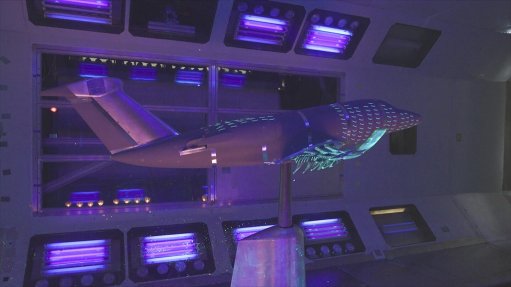
The eXtra Performance Wing wind-tunnel mode
Photo by: Airbus
Europe-based global major aerospace group Airbus has announced that it has completed wind-tunnel testing of its new wing technology demonstrator, the eXtra Performance Wing. This is part of the group’s programme to rapidly test and accelerate the development of new technologies to decarbonise the aviation sector.
Inspired by nature, the project was launched last September and is intended to reduce aircraft carbon dioxide emissions. The new technology wing is also intended to be compatible with any future aeroengines and aircraft configuration.
Design concepts for the wing were first tested by Airbus on a remotely controlled model aircraft, under a project designated AlbatrossONE. This tested wings which were ‘semi-aeroelastic’ and hinged. Inspired by the wings of seabirds, these wings could be unlocked in flight to respond to wind gusts and turbulence. In addition to furthering this concept, eXtra Performance Wing will also test technologies to be hosted by the wings, such as gust sensors, multifunctional trailing edges and pop-up spoilers, which would enable the wing to be actively controlled.
“The scaled demonstrator will integrate and fly breakthrough wing technologies using a remote-controlled Cessna Citation VII business jet platform in representative flight conditions,” explained eXtra Performance Wing UK head Oliver Family. “The partly three-dimensional-printed wind-tunnel model – expertly built by the aerodynamics team at Airbus’ low-speed wind-tunnel facility in Bristol [UK] – is a scaled-down version of the Cessna jet, incorporating the lightweight, long-span design of the eXtra Performance Wing that will provide the emissions benefits we are striving for.”
“[Our] state-of-the-art low-speed wind tunnel is a fantastic way to validate our concepts before flight tests,” he added. “Our computational aerodynamic analysis capability is world class, and the wind tunnel provides another valuable way to measure the performance and capabilities of the aircraft before flight testing. The technologies we have tested in the Filton [near Bristol] wind tunnel – many inspired by biomimicry – will now be rapidly integrated for flight testing.”
Airbus normally uses this low-speed wind tunnel to replicate conditions experienced by aircraft during take-off and landing. But it is also used by outside companies and agencies for a wide variety of other purposes, such as the testing of Formula 1 racing cars or of ship radar systems.
The eXtra Performance Wing project falls under Airbus wholly owned subsidiary Airbus UpNext. This was set up to fast-track the devel- opment of future technologies through the rapid assembly of demonstrators, and evaluating, validating and maturing these technologies.